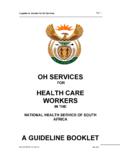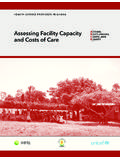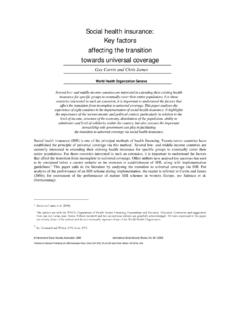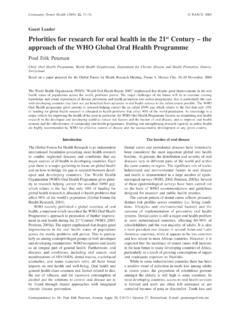Transcription of CONTENTS
1 health Systems profile - Oman Regional health Systems Observatory- EMRO. C ONTENTS. F O R E W O R D .. 3. A C K N O W L E D G E M E N T S .. 5. L I S T O F A B B R E V I A T I O N S .. 6. 1 E X E C U T I V E S U M M A R Y .. 8. 2 S O C I O E C O N O M I C G E O P O L I T I C A L M A P P I N G .. 11. Socio-cultural Factors .. 11. Economy .. 11. Geography and Climate .. 12. Political/ Administrative Structure .. 13. 3 H E A L T H S T A T U S A N D D E M O G R A P H I C S .. 15. health Status Indicators .. 15. Demography .. 17. Demographic patterns and 17. 4 H E A L T H S Y S T E M O R G A N I Z A T I O N.
2 21. Brief History of the health Care system .. 21. Public health Care system .. 24. Organizational structure of public 24. Private health Care 26. Overall health Care system .. 27. 5 G O V E R N A N C E /O V E R S I G H T .. 29. Process of Policy, Planning and management .. 29. Decentralization: Key characteristics of principal types .. 30. health Information 30. health Systems 31. Accountability Mechanisms .. 31. 6 H E A L T H C A R E F I N A N C E A N D E X P E N D I T U R E .. 35. health Expenditure Data and Trends .. 35. Tax-based Financing .. 37. Insurance .. 37. Out-of-Pocket Payments.
3 37. External Sources of Finance .. 37. Provider Payment Mechanisms .. 37. 7 H U M A N R E S O U R C E S .. 38. Human resources availability and creation .. 38. Human resources policy and reforms over last 10 43. Planned 44. 8 health SERVICE DELIVERY .. 45. Service Delivery Data for health services .. 45. Primary health Care .. 46. Secondary/Tertiary Care .. 47. Non personal Services: Preventive/Promotive Care .. 49. Long Term Care .. 51. Pharmaceuticals .. 51. Technology .. 51. 9 health system REFORMS .. 52. Summary of Recent and planned reforms .. 52. 10 REFERENCES .. 55. 1. health Systems profile - Oman Regional health Systems Observatory- EMRO.
4 TABLES. Socio-cultural Indicators 11. Economic Indicators 12. health Status Indicators 1990-2005 15. health Status Indicators by Gender (2005) 15. Top 10 Causes of Mortality / Morbidity (2005) 16. Spatial Distribution of Population (Mid-year Population for 2005) 18. Population Structure Indicators (Omani Population) 19. Demographic Indicators (Omani Population) 20. Resources for the health Care system By Various health Care Providers 35. Trends in health Expenditure in Oman 36. Sources of Finance (%) 36. health Workforce Stock in the Sultanate 1995 / 2000 / 2005 38. Changes in Workforce Densities 1995-2005 39.
5 Workforce Density in Selected Countries 39. Educational Institutions for health - 2005 41. Number of Graduates from MoH Educational Institutes 2005 42. Medical Graduates from Sultan Qaboos University 1993-2005 42. Service delivery data 45. Infrastructure for Primary health Care in Ministry of health (2005) 47. Infrastructure for Secondary health Care in MoH (2005) 48. Infrastructure for Tertiary health Care at National Level in MoH (2005) 49. Figures 1 Map of Oman 13. 2 Population Pyramid of the Omani Population (2005) 19. 3 Organization Structure of Ministry of health 28. 4 Physician and Nurse Population Ratios in EMR 40.
6 2. health Systems profile - Oman Regional health Systems Observatory- EMRO. F OREWORD. health systems are undergoing rapid change and the requirements for conforming to the new challenges of changing demographics, disease patterns, emerging and re emerging diseases coupled with rising costs of health care delivery have forced a comprehensive review of health systems and their functioning. As the countries examine their health systems in greater depth to adjust to new demands, the number and complexities of problems identified increases. Some health systems fail to provide the essential services and some are creaking under the strain of inefficient provision of services.
7 A number of issues including governance in health , financing of health care, human resource imbalances, access and quality of health services, along with the impacts of reforms in other areas of the economies significantly affect the ability of health systems to deliver. Decision-makers at all levels need to appraise the variation in health system performance, identify factors that influence it and articulate policies that will achieve better results in a variety of settings. Meaningful, comparable information on health system performance, and on key factors that explain performance variation, can strengthen the scientific foundations of health policy at international and national levels.
8 Comparison of performance across countries and over time can provide important insights into policies that improve performance and those that do not. The WHO regional office for Eastern Mediterranean has taken an initiative to develop a Regional health Systems Observatory, whose main purpose is to contribute to the improvement of health system performance and outcomes in the countries of the EM. region, in terms of better health , fair financing and responsiveness of health systems. This will be achieved through the following closely inter-related functions: (i) Descriptive function that provides for an easily accessible database, that is constantly updated; (ii).
9 Analytical function that draws lessons from success and failures and that can assist policy makers in the formulation of strategies; (iii) Prescriptive function that brings forward recommendations to policy makers; (iv) Monitoring function that focuses on aspects that can be improved; and (v) Capacity building function that aims to develop partnerships and share knowledge across the region. One of the principal instruments for achieving the above objective is the development of health system profile of each of the member states. The EMRO health Systems Profiles are country-based reports that provide a description and analysis of the health system and of reform initiatives in the respective countries.
10 The profiles seek to provide comparative information to support policy-makers and analysts in the development of health systems in EMR. The profiles can be used to learn about various approaches to the organization, financing and delivery of health services; describe the process, content , and implementation of health care reform programs; highlight challenges and areas that require more in-depth analysis; and provide a tool for the dissemination of information on health systems and the exchange of experiences of reform strategies between policy- makers and analysts in different countries. These profiles have been produced by country public health experts in collaboration with the Division of health Systems &.
















